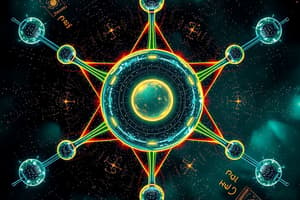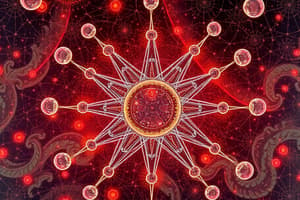Podcast
Questions and Answers
Which of the following is NOT a constituent of an atom?
Which of the following is NOT a constituent of an atom?
- Photon (correct)
- Neutron
- Electron
- Proton
Nucleons are only protons.
Nucleons are only protons.
False (B)
What force is responsible for holding the nucleus together, counteracting the electrostatic repulsion between protons?
What force is responsible for holding the nucleus together, counteracting the electrostatic repulsion between protons?
strong nuclear force
The process where a particle and its antiparticle collide and their masses are converted into energy is called ________.
The process where a particle and its antiparticle collide and their masses are converted into energy is called ________.
Which of the following statements is true regarding isotopes?
Which of the following statements is true regarding isotopes?
The nucleon number changes during beta-minus decay.
The nucleon number changes during beta-minus decay.
What is the name given to the particles of electromagnetic radiation?
What is the name given to the particles of electromagnetic radiation?
The energy of a photon is directly proportional to its ________.
The energy of a photon is directly proportional to its ________.
Match the force with its corresponding exchange particle:
Match the force with its corresponding exchange particle:
Which of the following is NOT a fundamental force?
Which of the following is NOT a fundamental force?
Leptons experience the strong nuclear force.
Leptons experience the strong nuclear force.
What two types of particles can Hadrons be further separated into?
What two types of particles can Hadrons be further separated into?
A particle composed of three quarks is classified as a ________.
A particle composed of three quarks is classified as a ________.
What is the quark composition of a proton?
What is the quark composition of a proton?
Strangeness is always conserved in weak interactions.
Strangeness is always conserved in weak interactions.
What is the purpose of fluorescent coating in a fluorescent tube?
What is the purpose of fluorescent coating in a fluorescent tube?
The minimum energy required for an electron to be emitted from the surface of a metal is known as the ________ ________.
The minimum energy required for an electron to be emitted from the surface of a metal is known as the ________ ________.
According to de Broglie's hypothesis, what happens to the wavelength of a particle as its momentum increases?
According to de Broglie's hypothesis, what happens to the wavelength of a particle as its momentum increases?
In electron diffraction, increasing the momentum of the electrons will cause the diffraction rings to move further apart.
In electron diffraction, increasing the momentum of the electrons will cause the diffraction rings to move further apart.
Explain why the scientific community only accepts ideas that have been peer-reviewed.
Explain why the scientific community only accepts ideas that have been peer-reviewed.
Flashcards
What is a proton?
What is a proton?
A subatomic particle located in the nucleus with a positive charge.
What is a neutron?
What is a neutron?
A subatomic particle located in the nucleus with no charge.
What is an electron?
What is an electron?
A subatomic particle orbiting the nucleus with a negative charge.
What is the proton number (Z)?
What is the proton number (Z)?
Signup and view all the flashcards
What is the nucleon number (A)?
What is the nucleon number (A)?
Signup and view all the flashcards
What are isotopes?
What are isotopes?
Signup and view all the flashcards
What is the strong nuclear force (SNF)?
What is the strong nuclear force (SNF)?
Signup and view all the flashcards
What is radioactive decay?
What is radioactive decay?
Signup and view all the flashcards
What is alpha decay?
What is alpha decay?
Signup and view all the flashcards
What is beta-minus decay?
What is beta-minus decay?
Signup and view all the flashcards
What are antimatter particles?
What are antimatter particles?
Signup and view all the flashcards
What is a photon?
What is a photon?
Signup and view all the flashcards
What is annihilation?
What is annihilation?
Signup and view all the flashcards
What is pair production?
What is pair production?
Signup and view all the flashcards
What are exchange particles?
What are exchange particles?
Signup and view all the flashcards
What are hadrons?
What are hadrons?
Signup and view all the flashcards
What are leptons?
What are leptons?
Signup and view all the flashcards
What properties are always conserved in particle interactions?
What properties are always conserved in particle interactions?
Signup and view all the flashcards
What is the work function?
What is the work function?
Signup and view all the flashcards
What is the photon model of light?
What is the photon model of light?
Signup and view all the flashcards
Study Notes
Particles
- An atom has three constituents: protons, neutrons, and electrons.
- Protons and neutrons form the nucleus and are known as nucleons.
- Electrons orbit the nucleus in shells.
Properties of Particles
- Particles exhibit properties described in SI and relative units.
- Specific charge is the ratio of charge to mass, calculated by dividing a particle's charge by its mass.
- A proton has a charge of +1.6 × 10⁻¹⁹ C and a mass of 1.67 × 10⁻²⁷ kg, resulting in a specific charge of 9.58 × 10⁷ Ckg⁻¹.
- Z denotes the proton number, or number of protons in an atom.
- A denotes the nucleon number, or number of protons and neutrons.
- 'X' represents the element's symbol in the notation ᴬZ X.
Isotopes
- Isotopes are atoms with the same number of protons but different numbers of neutrons.
- Carbon-14 dating determines the age of organic material by measuring carbon-14 percentage and using its half-life.
Stable and Unstable Nuclei
- Keeps nuclei stable by counteracting electrostatic repulsion between protons
- Only acts on nucleons and has a short range attraction up to 3 fm and is repulsive below 0.5 fm. repulsive below separations of 0.5 fm.
- Unstable nuclei decay due to an imbalance in the number of protons and/or neutrons.
Alpha Decay
- Occurs in large nuclei with too many protons and neutrons.
- Results in a decrease of 2 in the proton number and 4 in the nucleon number.
Beta-Minus Decay
- Occurs in neutron-rich nuclei.
- Boosts the proton number by 1 while the nucleon number stays the same.
- Neutrinos were hypothesised to account for the energy not conserved during beta-minus decay and later observed.
Particles, Antiparticles, and Photons
- Each particle has an antiparticle with the same rest energy and mass, but opposite properties.
- Example: a positron is the antiparticle of the electron.
- Electromagnetic radiation such as photons transfer energy and have no mass.
- Photon energy is proportional to electromagnetic radiation frequency: E = hf = hc/λ, where h is Planck's constant (6.63 × 10⁻³⁴ Js).
Annihilation
- Particle and antiparticle collide, converting mass into energy released as two photons in opposite directions.
- Application in PET scanners involves positron-emitting radioisotopes annihilating with electrons, emitting detectable gamma photons.
Pair Production
- A photon converts into matter and antimatter.
- Involves the photon exceeding total rest energy of both particles, with excess energy converted to kinetic energy.
Particle Interactions
- Fundamental forces include gravity, electromagnetism, weak nuclear force, and strong nuclear force.
- Forces are caused by exchange particles which transfer energy and momentum.
Interactions and Exchange Particles
- Strong: Gluon, range of 3 × 10⁻¹⁵ m, acts on Hadrons
- Weak: W boson (W⁺ or W⁻), range of 10⁻¹⁸ m, acts on all particles
- Electromagnetic: Virtual photon (γ), infinite range, acts on charged particles
- Gravity: Graviton (not on specification), infinite range, acts on particles with mass
- The weak nuclear force is responsible for beta decay, electron capture, and electron-proton collisions.
Electron Capture Equation
- p + e⁻ → n + vₑ
Electron-Proton Collision
- p + e⁻ → n + vₑ
- Equations for electron capture and electron-proton collisions are the same, but a different exchange particle is used.
Beta-Plus Decay
- p → n + e⁺ + vₑ
Beta-Minus Decay
- n → p + e⁻ + v̄ₑ
Classification of Particles
- Particles are classified as either hadrons or leptons
- Leptons are fundamental particles and do not experience the strong nuclear force.
- Hadrons are formed of quarks and experience the strong nuclear force.
- Hadrons are further separated into baryons, antibaryons, and mesons.
- Baryons are formed of 3 quarks, antibaryons are formed of 3 antiquarks, and mesons are formed from a quark and antiquark.
Baryon Number
- Indicates if a particle is a baryon (1), antibaryon (-1), or neither (0).
- Baryon number is always conserved in particle interactions.
- The proton is the only stable baryon, and all baryons will decay into a proton.
Lepton Number
- Indicates if a particle is a lepton (1), antilepton (-1), or neither (0).
- Electron lepton number and muon lepton number represent the named particle.
- Lepton number is always conserved in particle interactions.
- Muons are sometimes called "heavy electrons" and decay into electrons.
Strange Particles
- Produced by the strong nuclear interaction but decay by the weak interaction.
- The only strange particles you are expected to know about are kaons, which decay into pions, through the weak interaction.
Strangeness
- A property of particles indicating that strange particles must be created in pairs, as strangeness must be conserved in strong interactions.
- In weak interactions, strangeness can change by 0, +1, or -1.
- Scientific investigations in particle physics rely on international collaboration due to high costs and large data volumes.
Quarks and Antiquarks
- Quarks are fundamental particles that make up hadrons, with three types of quarks to know.
- Antiquarks have opposite signs for their properties compared to quarks.
Quark Combinations
- uud forms a proton (charge +e, baryon number +1).
- udd forms a neutron
Finding Quark Combination of Antibaryon
- Change the quarks into their respective antiquarks.
- The same is true for mesons.
Quark Combinations for Mesons
- π⁰: uū or d̄d, Charge: 0, Strangeness: 0
- π⁺: ud, Charge: +1, Strangeness: 0
- π⁻: ūd, Charge: -1, Strangeness: 0
- K⁰: d̄s or d̄s, Charge: 0, Strangeness: ±1
- K⁺: us, Charge: +1, Strangeness: +1
- K⁻: ūs , Charge: -1, Strangeness: -1
Applications of Conservation Laws
- Must be conserved in particle interactions: energy, momentum, charge, baryon number, electron lepton number, muon lepton number.
- Strangeness is conserved during strong interactions.
- To evaluate conservation laws, compare property values before and after the interaction.
Beta-Minus Decay of a Neutron
- n → p + e⁻ + v̄ₑ (Strangeness does not need to be conserved)
- Before Interaction: Charge 0, Baryon number 1, Electron lepton number 0, Muon lepton number 0, Strangeness 0
- After Interaction: Charge 1+(-1)+0=0, Baryon number 1+0+0, Electron lepton number 0+1-1, Muon lepton number 0+0+0, Strangeness 0+0+0
- Change: 0 for all properties; therefore, the interaction is possible.
Quark Type Changes
- Beta-minus and beta-plus decay are caused by the weak interaction because there is a change of quark type.
- In beta-minus decay, a down quark changes into an up quark (neutron to proton).
- The opposite happens in beta-plus decay.
The Photoelectric Effect
- Photoelectrons are emitted from the surface of a metal after light of a certain frequency shines on it. This frequency is called the threshold frequency and varies for different metals.
- EM waves travel in discrete packets called photons, which have an energy directly proportional to frequency.
- The electron can absorb a single photon, so a photoelectron is only emitted if the frequency is above the threshold frequency.
- If the light’s intensity is increased above the threshold, more photoelectrons are emitted per second.
Work Function
- The work function (φ) is the minimum energy required for electrons to be emitted from the surface of a metal.
Stopping Potential
- V(s) is the potential difference needed to stop photoelectrons, allowing the determination of maximum kinetic energy: E(k max) = eV(s).
Photoelectric Equation Formula
- The photoelectric equation, E = hf = φ + E(k max), relates work function, maximum kinetic energy, and light frequency.
Collisions of Electrons with Atoms
- Electrons in atoms exist in discrete energy levels.
- Excitation is when electrons gain energy from collisions and move up energy levels.
- Ionisation occurs when electrons gain enough energy to be removed from the atom entirely.
- Ionisation occurs if the energy of the free electron is greater than the ionisation energy.
- Excited electrons return to their ground state, releasing energy as photons.
- Fluorescent tubes use mercury vapour and a high voltage to produce light via excitation and photon emission.
Conversion of electron volts
- An electron volt is the energy gained by one electron passing through a potential difference of 1 volt.
- 1 eV = e × 1 = 1.6 × 10⁻¹⁹ J
Converting from eV to joules
- Multiply your value by 1.6 × 10⁻¹⁹
Converting from Joules to eV
- Divide your value by 1.6 × 10⁻¹⁹
Energy Levels and Photon Emission
- Passing light from a fluorescent tube through a diffraction grating or prism produces a line spectrum.
- Each line represents a different wavelength of emitted light corresponding to the energies emitted.
- Discrete wavelengths in the spectrum indicate that electrons in atoms can only transition between discrete energy levels.
- Passing white light through a cooled gas results in a line absorption spectrum.
- Black lines in the spectrum represent photons of energy absorbed by atoms in the gas.
Energy Difference Formula
- An equal specific photon energy is emitted by a fluorescent tube.
- ΔΕ = Ε₁ - Ε₂, where E₁ and E₂ represent energy levels.
- As E = hf, therefore hf = E₁ - E₂.
Wave-Particle Duality
- Light exhibits both wave (diffraction and interference) and particle properties (photoelectric effect).
- Electrons also exhibit both wave and particle properties as they can participate in electron diffraction, as only waves can experience diffraction.
De Broglie
- The equation relating the wavelength (λ) of an object to its momentum (mv): λ = h/mv, where h is Planck’s constant.
- As momentum increases, wavelength decreases, and diffraction decreases.
- As momentum decreases, wavelength increases, and diffraction increases.
Acceptance of Duality
- Experimental evidence (electron diffraction, photoelectric effect) led to the recognition of wave-particle duality.
- Scientific concepts evolve with experimental evidence, peer review, validation, and community acceptance.
Studying That Suits You
Use AI to generate personalized quizzes and flashcards to suit your learning preferences.




